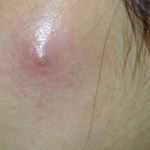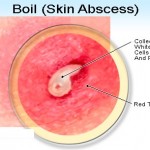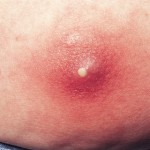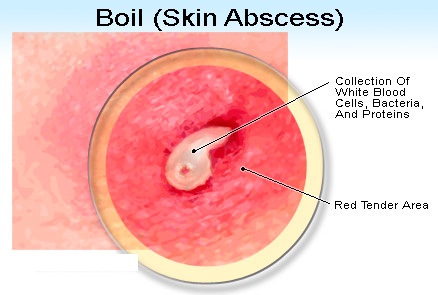A skin abscess is a localized collection of pus that generally develops in response to infection or to the presence of other foreign materials under the skin. An abscess is typically painful, and it appears as a swollen area that is warm to the touch. The skin surrounding an abscess typically appears pink or red.
 Abscesses can develop in many parts of the body, but they usually involve the skin surface. Skin abscesses are often referred to as boils. Common sites affected include the armpits, groin, rectal area (perirectal abscess), the external vaginal area (Bartholin’s abscess), and along the tailbone(pilonidal abscess). Inflammation surrounding hair follicles or sweat glands can lead to the formation of abscesses, as well. Abscesses can also affect the brain, kidneys, liver (hepatic abscess), lungs, breast, neck, teeth (dental abscess), and tonsils (peritonsillar abscess).
Abscesses can develop in many parts of the body, but they usually involve the skin surface. Skin abscesses are often referred to as boils. Common sites affected include the armpits, groin, rectal area (perirectal abscess), the external vaginal area (Bartholin’s abscess), and along the tailbone(pilonidal abscess). Inflammation surrounding hair follicles or sweat glands can lead to the formation of abscesses, as well. Abscesses can also affect the brain, kidneys, liver (hepatic abscess), lungs, breast, neck, teeth (dental abscess), and tonsils (peritonsillar abscess).
Unlike other infections, antibiotics alone will not typically cure a skin abscess. In general, abscesses must open and drain to improve. Although sometimes an abscess will open and drain spontaneously, it often needs to be lanced (incision and drainage) by a health-care provider. Certain abscesses may require drainage in an operating room.
Skin abscesses are typically caused by either an inflammatory reaction to an infectious process (bacteria or parasite) or, less commonly, to a foreign substance within the body (a needle or a splinter, for example). Abscesses may develop because of obstructed oil (sebaceous) or sweat glands, inflammation of hair follicles, or from minor breaks and punctures of the skin. Abscesses may also develop after a surgical procedure.
The infectious organisms or foreign material cause an inflammatory response in the body, which triggers the body’s immune system to form a cavity or capsule to contain the infection and prevent it from spreading to other parts of the body. The interior of the abscess liquefies, and pus develops (which contains dead cells, proteins, bacteria, and other debris). This area then begins to expand, creating increasing tension and inflammation of the overlying skin.
The most common bacterial organism responsible for the development of skin abscesses is Staphylococcus aureus, although various other organisms can also lead to abscess formation With the emergence of methicillin-resistant Staphylococcus aureus (MRSA), health-care providers must now consider this organism as the possible cause when a skin abscess is encountered.
 People with weakened immune systems (either from a chronic disease or from medications) can develop abscesses more often because their body’s ability to fight infection is decreased. Individuals with any of the following conditions are at higher risk for developing abscesses:
People with weakened immune systems (either from a chronic disease or from medications) can develop abscesses more often because their body’s ability to fight infection is decreased. Individuals with any of the following conditions are at higher risk for developing abscesses:
- Chronic steroid therapy
- Chemotherapy
- Diabetes
- Cancer
- Dialysis for kidney failure
- AIDS
- Sickle cell disease
- Peripheral vascular disease
- Crohn’s disease
- Ulcerative colitis
- Severe burns
- Severe trauma
Skin Abscess Symptoms and Signs
The symptoms of a skin abscess vary depending on the location of the abscess, but in general, individuals will experience the following:
- Most often, an abscess becomes a painful, compressible mass that is red, warm to the touch, and tender.
- As an abscess progresses, it may “point” and come to a head. Pustular drainage and spontaneous rupture may occur.
- Most abscesses will continue to get worse without care and proper incision and drainage. The infection can potentially spread to deeper tissues and even into the bloodstream.
- If the infection spreads, fever, nausea, vomiting, increasing pain, and increasing skin redness may develop.
When to Seek Medical Care
A skin abscess will sometimes rupture and drain spontaneously at home without any further complications. However, in some instances, further evaluation by a health-care provider is necessary to prevent the progression and complications associated with a continuing infection. Consult a health-care provider if any of the following scenarios occurs with an  abscess:
abscess:
- The sore is larger than 1 cm or ½ inch across.
- The sore fails to heal or it continues to enlarge and becomes more painful.
- The person has an underlying illness such as AIDS, cancer, diabetes, sickle cell disease, or peripheral vascular disease.
- The person is an IV drug abuser.
- The person is on steroid therapy, chemotherapy, or dialysis.
- The sore is located at the top of the buttock crease, or it is on or near the rectal or groin area.
- The person has a fever of 100.4 F or higher.
- There is a concern that there is foreign material within a wound or under the skin.
Go to a hospital’s emergency department if any of these conditions occur with an abscess:
- Fever of 102 F or higher, or vomiting, especially if the person has a chronic disease or is on steroids, chemotherapy, or dialysis
- There is a spreading red streak on the skin originating from the abscess.
- Any facial abscess larger than 1 cm or ½ inch across
